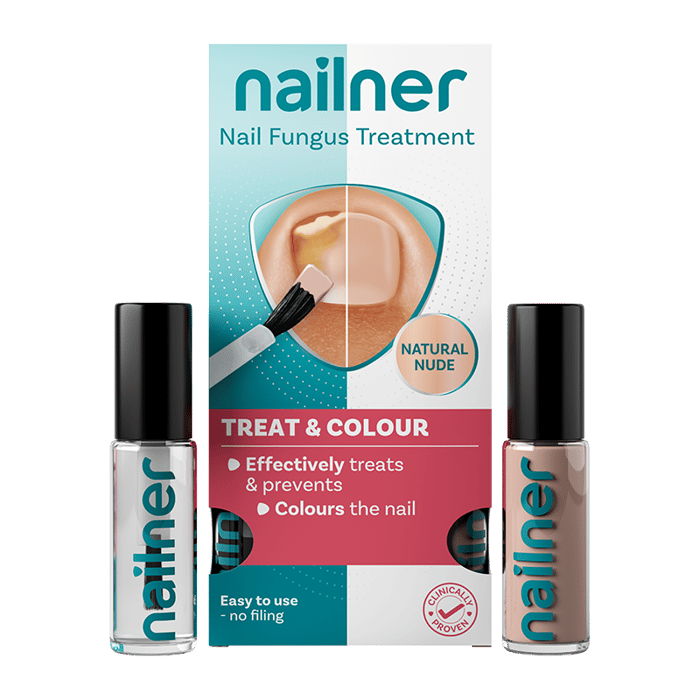Ugly Nails
Why are my nails so ugly? If this is a question that you keep asking yourself, then you are far from alone. While in the winter, you can cover up ugly nails with tights and boots, but when flip-flop weather comes, you have to get ready to bare your nails to the world.
When it comes to ugly nails, there are lots of possible reasons why your fingers and toes may not be looking their best. Maybe you have neglected them for too long? Perhaps you have gone overboard with artificial nails? Or the most likely cause, you have a fungal nail infection. Unpleasant for many, fungal nail infections happen to most people at some point in their lives, so there is nothing to be ashamed about. Plus, they are easy to treat!
Read more about
What causes ugly nails
Ugly nails can affect both the fingernails and toenails and can be not only aesthetically displeasing, but in some cases, they can also cause discomfort or even make carrying out basic daily tasks difficult.
If you are experiencing ugly nails, there are several possible causes:
Fungal nail infection
The most common cause of ugly nails is a fungal infection. This can occur on both the fingernails and toenails but is more prevalent on the latter.
The most common symptoms of a fungal nail infection include:
- Yellow nails
- Thick nails
- A bad odour
- Brittle nails
- Curved nails
- A nail that is coming away from the nail bed
A fungal nail infection occurs when there is an overgrowth of fungi in or under the nail. The same fungi that causes Athlete’s foot, jock itch, and ringworm can cause nail infections.
Anyone can get a fungal nail infection, although it is more common in people aged over 50, those with a weakened immune system, and people with poor circulation.
Fungus thrives in moist and warm environments, so if you regularly go to public swimming pools, health spas, or gyms and you go barefoot, you are much more likely to pick up a fungal infection.
You can also get a nail infection if you come into contact with someone else who has had a fungal infection. So, if someone in your household has a fungal nail infection, other family members are much more likely to get one too.
The good thing about a fungal nail infection is that it is fairly easy to treat. You don’t need to go to the doctor to get a prescription. Simply head to your local pharmacy and ask for Nailner Nail Fungus treatment.
Psoriasis
For those experiencing psoriasis, this can lead to ugly nails. In fact, most people with plaque psoriasis will develop nail psoriasis at some point.
Nail psoriasis can cause:
- Dents in the nails
- Lifting of the nails
- Discolouration
- Thickening
- Crumbling
It is also possible to develop nail psoriasis even if you don’t have psoriasis on other parts of your body.
If you have nail psoriasis, the most important thing to do is keep your nails protected and looked after.
Artificial nails
If you regularly get artificial nails, you will know only too well that this can result in flare nails, ugly for you to look at. In particular, acrylic nails can wreak havoc with your natural ones, causing flaking, chipping, and broken nails.
Although acrylic nails do not always cause damage to your nails, if they do, you may experience the below symptoms:
- Nails that are painful to touch
- Nails that are visibly damaged
- Thin nails
- Brittle nail beds
- Nails that bend or break easily
Typically, ugly nails happen if you have used an unskilled or inexperienced nail technician who has not applied your nails in the right way or if low-quality artificial nails have been used.
To avoid ugly nails from acrylics, make sure that you only use a qualified nail technician and, where possible, limit your use of artificial nails.
Nail polish staining
Although nail polish is designed to make your fingernails and toenails look pretty, not ugly, if you use it too often or leave it on for too long, it can cause staining.
As a general rule, the darker the polish, the more likely it is to result in staining. This is particularly true for red and purple polishes that are prone to leaving stubborn stains on the nails.
Fortunately, you don’t have to give up your colourful nails. Simply make sure that you pick a good-quality nail polish and always apply a base coat first to protect your nails. It can also be a good idea to remove the nail polish and give your nails a few days to breathe every now and again.
Trauma
If you have injured your finger, toe, or nails, then this can lead to ugly nails. Furthermore, if you wear restricting footwear such as shoes that are too tight or ones that force your feet into an unnatural shape, this can also cause trauma to the area and lead to ugly nails.
Trauma can also affect the nail long after it has occurred. For example, if you have previously lost a fingernail or toenail, then the new nail may grow back thicker or with a ridge.
There is not really much that you can do to treat trauma to the nail. You simply have to let time heal the injury and wait for the nail to grow back. For fingernails, this can take up to 6 months and, for toenails, anywhere between 12-18 months.
Ugly nails can also occur as a result of constantly biting or picking at your nails. If you have ugly nails from biting, then you may want to try a stop nail biting polish that you apply to the nails and which has a nasty taste that is designed to stop you from biting.
Systemic disease
Systemic diseases such as diabetes, peripheral arterial disease, and thyroid disease can change the appearance of the nails and lead to ugly nails.
You may notice:
- A change in colour – your nails may become white, yellow, or even green/black
- Brittle nails
- Nails that are difficult to trim
Nail clubbing, a nail disorder, is often the result of lung or heart disease. In terms of treatment, if your ugly nails are the result of another health condition, then your doctor will look to treat this rather than the nails
Certain medications
If you take certain medications, this can affect the appearance of your nails and may lead to ugly nails.
Some of the most common drug interactions include:
- Chemotherapy which can cause Beau’s lines
- Tetracycline that can cause black nails
- Arsenic poisoning, which can lead to white lines known as Mee’s lines
Your doctor should talk to you about any side effects of your medication, and, if you are not happy with these, you may want to ask if there is an alternative drug you can take.

What are the symptoms of ugly nails
Depending on the cause of your ugly nails, you may experience some or all of the below symptoms:
- Discolouration – this could be the nails turning yellow, white, green, red, or even black
- Change in shape – your nails may become curved
- Change in texture – your nails may become brittle, flaky, or crumble
- A bad odour
- Stained nails
- Chipped nails
- Nail streaks
- Cracked nails
If you experience any swelling, pain, or discomfort, make an appointment with your doctor to rule out anything serious.
How to treat ugly nails
The most common cause of ugly nails is a fungal nail infection which is fairly easy to treat. If you have the symptoms of a fungal infection such as yellow nails, brittle or thickened nails and/or a bad odour, you do not need to make an appointment with your doctor.
Instead, head to your local pharmacy or order an anti-fungal treatment online. Nailner Nail Fungus Treatment is available as a topical treatment that you apply directly to the affected area.
You can also get anti-fungal foot sprays and powders which can help prevent the fungus from growing or coming back.
It is worth noting that it can take several months for a fungal nail infection to clear up, although you should see signs of improvement within 10-14 days.
If you do not notice any improvement in the appearance of your ugly nails by this time, you may want to make an appointment with your doctor to rule out an underlying health condition.
For ugly nails that are the result of nail treatments or nail polish, the best treatment is time. You should refrain from having artificial nails placed on your nail beds and limit your use of nail polish.
If your ugly nails are caused by an injury or some form of trauma, again, time is the best healer. However, toenails take a long time to regrow (up to 18 months), so you need to be patient.

How to prevent ugly nails
The best way to prevent ugly nails is to take good care of both your fingernails and toenails. Although often overlooked, keeping your nails healthy can help to prevent a whole host of nail problems, including fungal infections, bacterial infections, and other nail disorders.
To keep your fingernails and toenails looking their best:
- Wash your nails regularly
- Avoid prolonged contact with water
- Practice good nail hygiene
- Moisturise your hands and feet, including your nails and cuticles
- Apply a protective base coat layer before nail polish
- Take a biotin supplement
- Do not bite or pick at your fingernails
- Do not pull off hangnails
- Wear protective gloves to avoid injury
- Use a foot powder to absorb sweat in your shoes
- Limit your use of artificial nails
Lastly, do not ignore any worrying symptoms or nail abnormalities, even if they seem minor. Most nail problems can be easily cured, but they can quickly worsen and become more problematic if left untreated.
How to cover up ugly nails
The coverage of an ugly nail is simple. If you have an infection, you can use a medicated nail polish. These are made of anti-fungal, antibacterial, and antimicrobial ingredients, which will not only help to fight off the fungus but will also cover up the signs of infection.
Medicated nail polish can be applied to both your fingernails and toenails and is safe to use alongside other anti-fungal treatments such as topical creams and oral tablets.
For men, you can also get medicated nail polish that is transparent in colour so you can hide the fungus without having to wear a bright shade of polish.

Frequently asked questions
Do dry feet causes ugly nails
While overly dry feet can cause flaking of the skin, it is highly unlikely that this will lead to ugly nails. In fact, keeping your feet dry is one of the most effective ways to prevent nail fungus from growing, so it is a good foot care practice for reducing your risk of a fungal nail infection.
When drying your hands and feet, always use a clean towel and make sure that you dry between the fingers and toes, as this is where fungus thrives.
What to do if your nails are ugly
If you have ugly nails, there are several treatments available that can make your nails healthy and normal again. If you have a fungal nail infection, then anti-fungal medication can banish yellow, thick, and ugly nails.
Or, if your ugly nails are a result of artificial nails or the over-use of harsh nail polishes, you should simply take a break from these treatments and let your nails recover.













